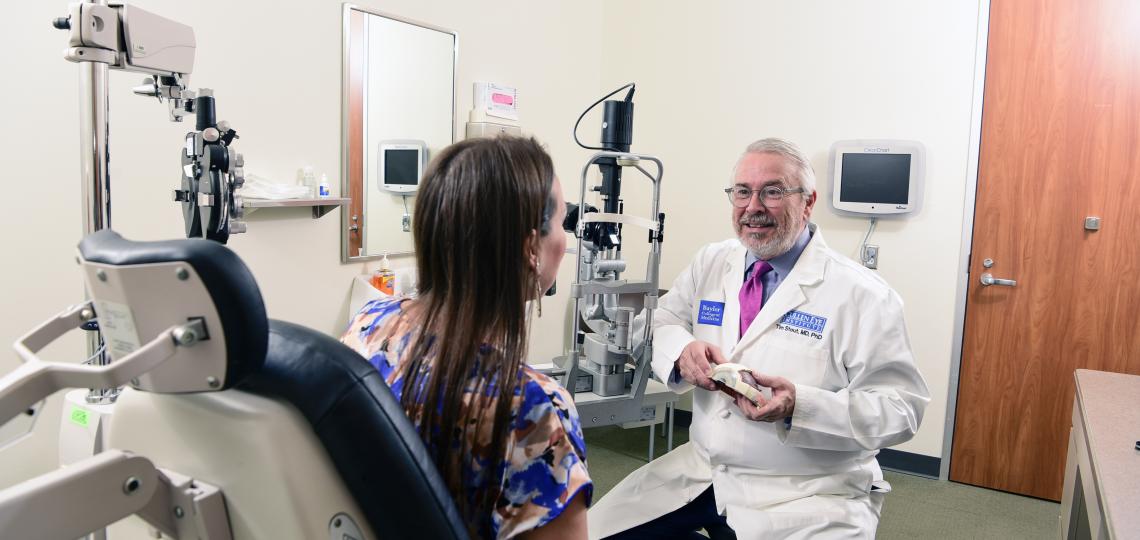Advanced Refractive Surgeries in AL: Explore Options at Our Clinic
Advanced Refractive Surgeries in AL: Explore Options at Our Clinic
Blog Article
Checking Out the State-of-the-Art Technologies Made Use Of for Treating and detecting Eye Conditions
In the world of ophthalmology, the development of modern technology has significantly boosted the devices available for identifying and treating numerous eye problems. From advanced imaging technologies that give comprehensive understandings right into ocular frameworks to robotic-assisted surgeries that supply unrivaled accuracy, the landscape of eye treatment is continuously developing. With the combination of expert system in diagnostics, genetics treatment innovations, and online truth rehab, the possibilities for enhancing patient outcomes are increasing at a rapid pace. The convergence of these advanced innovations holds the pledge of reinventing the field of ophthalmology, using brand-new opportunities for personalized and effective treatments.

Advanced Imaging Technologies
Advanced Imaging Technologies have changed the area of ophthalmology by offering thorough and accurate visualization of the eye structures. Optical Comprehensibility Tomography (OCT) attracts attention as a key modern technology in this world. OCT uses light waves to record high-resolution cross-sectional photos of the retina, permitting the identification of minute structural modifications. This non-invasive method aids in the early detection and tracking of various eye conditions such as macular deterioration, diabetic retinopathy, and glaucoma.
Additionally, Fundus Digital photography is one more necessary tool in sensory imaging. This method involves capturing thorough photos of the back of the eye, including the retina and optic disc. Fundus Digital photography helps in recording the development of eye illness, assessing treatment effectiveness, and informing individuals concerning their eye health.

Robotic-Assisted Operation
Robotic-assisted operations have actually significantly advanced the capabilities of ophthalmic surgical procedure, ushering in a new era of precision and efficiency in treating numerous eye problems. By incorporating robot technology into procedures, eye doctors can achieve unmatched precision and control, leading to boosted person end results.
Among the main benefits of robotic-assisted surgical treatment in ophthalmology is the boosted dexterity and security it uses to specialists. The robot arms can carry out precise motions with a high degree of accuracy, enabling delicate treatments with marginal invasiveness. This degree of accuracy is particularly helpful in surgical treatments including the retina, where also minor mistakes can have substantial effects for an individual's vision.
Furthermore, robotic-assisted medical systems offer real-time imaging and responses to the doctor, enabling them to make enlightened decisions during the treatment. This innovation improves the doctor's situational awareness and allows for modifications to be made quickly, making sure ideal results for the client.
Expert System in Diagnostics
With the evolution of advanced modern technologies improving surgical accuracy in ocular procedures, the integration of Artificial Knowledge in diagnostics has emerged as an essential advancement transforming the area of eye care. Artificial Intelligence (AI) formulas are being progressively used to assess complicated data from imaging technologies like optical coherence tomography (OCT) and fundus digital photography to help in the early detection and exact medical diagnosis of numerous eye conditions. These AI systems can successfully identify patterns and anomalies in photos that may not be discernible to the human eye, making it possible for quicker diagnosis and therapy planning.
AI algorithms can additionally anticipate illness development, suggest customized therapy strategies, and evaluate the effectiveness of interventions. By enhancing the diagnostic procedure, AI not only enhances the effectiveness of eye care specialists yet likewise enhances patient end results by making it possible for timely treatments. As AI remains to advance, its role in diagnostics is anticipated to broaden, supplying new possibilities for very early treatment and individualized therapy in the area of ophthalmology.
Genetics Therapy Technologies
In the realm of ophthalmic advancements, recent strides in genetics therapy innovations have stimulated considerable passion amongst researchers and medical care professionals alike. Gene treatment holds immense promise in transforming the treatment of different eye conditions by targeting the underlying hereditary reasons. By introducing genetic material into cells to make up for unusual genes or to supply an absent genetics, genetics treatment provides a customized technique to dealing with inherited eye disorders such as retinitis pigmentosa, Leber hereditary amaurosis, and others that were previously taken into consideration untreatable.

As research study in gene therapy proceeds to development, the potential for customized treatments for a wider series of eye conditions expands, using new hope for patients with hereditary eye conditions.
Digital Truth Recovery
Virtual fact recovery has actually become a sophisticated technique in boosting the recovery and rehab procedures for people with various visual problems. refractive surgeries in al. By imitating real-world settings through immersive innovation, virtual reality uses an one-of-a-kind platform for vision treatment and recovery. This ingenious method allows individuals to engage in interactive workouts and official statement activities created to boost aesthetic skill, depth assumption, eye control, and total visual performance
One trick advantage of virtual truth rehab is its capability to customize treatment programs based on the certain demands and capacities of each individual. Via real-time responses and monitoring, healthcare professionals can track progression, change interventions, and give individualized like optimize outcomes. Additionally, digital reality technology can develop a safe and regulated room for hearing service near me people to exercise visual jobs, get rid of difficulties, and build self-confidence in a virtual setting before transitioning to real-world situations.
Conclusion
In final thought, the innovations in imaging technologies, robotic-assisted surgeries, synthetic intelligence diagnostics, gene therapy developments, and virtual reality rehabilitation have considerably improved the diagnosis and treatment of eye problems. refractive surgeries in al. These advanced innovations have transformed the field of ophthalmology, allowing for even more exact and effective procedures. As modern technology proceeds to progress, the future of eye care looks promising with the possibility for even more ingenious services to improve patient end results
In the world of ophthalmology, the evolution of technology has actually substantially improved the tools readily available for identifying and treating numerous eye problems. Fundus Photography aids in recording the development of eye conditions, examining therapy efficiency, and educating patients regarding their eye health.
Artificial Knowledge (AI) formulas are being significantly utilized to analyze complex data from imaging technologies like optical comprehensibility tomography (OCT) and fundus photography to aid in the early detection and exact medical diagnosis of different eye conditions.In final thought, the advancements in imaging innovations, robotic-assisted surgical treatments, synthetic intelligence diagnostics, gene therapy innovations, and digital truth recovery have substantially improved the diagnosis and therapy of eye conditions. As innovation proceeds to evolve, the future of eye treatment looks encouraging with the potential for also more cutting-edge services to boost patient results.
Report this page